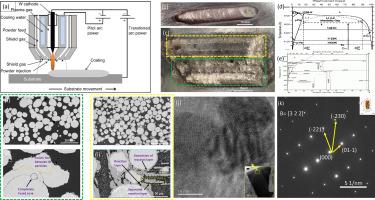Microstructural characterization of Wcu composite deposition on mild steel fabricated via plasma transferred arc welding
IF 4.6
2区 材料科学
Q2 MATERIALS SCIENCE, MULTIDISCIPLINARY
International Journal of Refractory Metals & Hard Materials
Pub Date : 2025-09-12
DOI:10.1016/j.ijrmhm.2025.107445
引用次数: 0
Abstract
In this study, a tungsten‑copper (W![]() Cu) composite was successfully deposited on mild steel substrate using a novel technique—Plasma Transferred Arc (PTA) welding. Spherical W and Cu powders were employed, and the resulting microstructural characteristics on a mild steel substrate were thoroughly analysed. Key PTA process parameters were established and found to significantly influence microstructural evolution. Notably, iron (Fe) dilution from the base metal markedly altered the composite's microstructure, and grain boundary diffusion of Cu into the mild steel substrate was observed. The size and morphology of W powder were found to affect the homogeneity and porosity of the deposited layer. X-ray diffraction and EDS point analysis revealed the formation of a new intermetallic phase, Fe₇W₆, around W particles. For the first time, a new intermetallic phase FeW was also confirmed by point EDS analysis. The intermetallic phase Fe₇W₆ was further confirmed by transmission electron microscopy (TEM) diffraction, indicating its stability at room temperature. Higher hardness values of the intermetallic phase were compared to other phases present in the composite.
Cu) composite was successfully deposited on mild steel substrate using a novel technique—Plasma Transferred Arc (PTA) welding. Spherical W and Cu powders were employed, and the resulting microstructural characteristics on a mild steel substrate were thoroughly analysed. Key PTA process parameters were established and found to significantly influence microstructural evolution. Notably, iron (Fe) dilution from the base metal markedly altered the composite's microstructure, and grain boundary diffusion of Cu into the mild steel substrate was observed. The size and morphology of W powder were found to affect the homogeneity and porosity of the deposited layer. X-ray diffraction and EDS point analysis revealed the formation of a new intermetallic phase, Fe₇W₆, around W particles. For the first time, a new intermetallic phase FeW was also confirmed by point EDS analysis. The intermetallic phase Fe₇W₆ was further confirmed by transmission electron microscopy (TEM) diffraction, indicating its stability at room temperature. Higher hardness values of the intermetallic phase were compared to other phases present in the composite.

等离子转移弧焊制备低碳钢Wcu复合镀层的显微组织表征
在本研究中,采用等离子转移电弧(PTA)焊接技术成功地在低碳钢基体上沉积了钨铜(WCu)复合材料。采用球形W和Cu粉末,对其在低碳钢基体上的显微组织特征进行了深入分析。建立了关键的PTA工艺参数,并发现其对微观组织演化有显著影响。值得注意的是,母材中的铁(Fe)稀释显著改变了复合材料的显微组织,并且观察到Cu在低碳钢基体中的晶界扩散。W粉的尺寸和形貌影响了沉积层的均匀性和孔隙率。x射线衍射和EDS点分析显示,在W颗粒周围形成了一种新的金属间相Fe₇W₆。点能谱分析首次证实了一种新的金属间相。通过透射电镜(TEM)衍射进一步证实了Fe₇W₆的金属间相,表明其在室温下的稳定性。与复合材料中存在的其他相相比,金属间相的硬度值更高。
本文章由计算机程序翻译,如有差异,请以英文原文为准。
求助全文
约1分钟内获得全文
求助全文
来源期刊
CiteScore
7.00
自引率
13.90%
发文量
236
审稿时长
35 days
期刊介绍:
The International Journal of Refractory Metals and Hard Materials (IJRMHM) publishes original research articles concerned with all aspects of refractory metals and hard materials. Refractory metals are defined as metals with melting points higher than 1800 °C. These are tungsten, molybdenum, chromium, tantalum, niobium, hafnium, and rhenium, as well as many compounds and alloys based thereupon. Hard materials that are included in the scope of this journal are defined as materials with hardness values higher than 1000 kg/mm2, primarily intended for applications as manufacturing tools or wear resistant components in mechanical systems. Thus they encompass carbides, nitrides and borides of metals, and related compounds. A special focus of this journal is put on the family of hardmetals, which is also known as cemented tungsten carbide, and cermets which are based on titanium carbide and carbonitrides with or without a metal binder. Ceramics and superhard materials including diamond and cubic boron nitride may also be accepted provided the subject material is presented as hard materials as defined above.

 求助内容:
求助内容: 应助结果提醒方式:
应助结果提醒方式:


